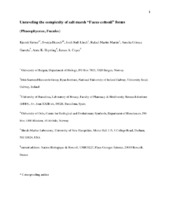| dc.contributor.author | Sjøtun, Kjersti | |
| dc.contributor.author | Heesch, Svenja | |
| dc.contributor.author | Lluch, Jordi Rull | |
| dc.contributor.author | Martín, Rafael Martín | |
| dc.contributor.author | Garreta, Amelia Gómez | |
| dc.contributor.author | Brysting, Anne Krag | |
| dc.contributor.author | Coyer, James A. | |
| dc.date.accessioned | 2018-03-20T13:48:33Z | |
| dc.date.available | 2018-03-20T13:48:33Z | |
| dc.date.issued | 2017 | |
| dc.Published | Sjøtun K, Heesch S, Lluch, Martín, Garreta, Brysting AK, Coyer JA. Unravelling the complexity of salt marsh ‘Fucus cottonii’ forms (Phaeophyceae, Fucales). European journal of phycology. 2017;52(3):360-370 | eng |
| dc.identifier.issn | 0967-0262 | en_US |
| dc.identifier.issn | 1469-4433 | en_US |
| dc.identifier.uri | https://hdl.handle.net/1956/17533 | |
| dc.description.abstract | Genetic affiliation, nuclear DNA content, and gamete functioning were examined in small salt marsh Fucus from three localities in western Ireland. Individuals with small and dioecious receptacles were found at all localities, but production of germlings was only evident at Locality 1. Here, the Fucus vegetation formed a morphological cline from F. vesiculosus with bladders in the mid-intertidal to small Fucus individuals lacking bladders in the salt marsh of the upper intertidal. Measurements of nuclear DNA content ranged from 1–1.8 pg at this locality, with F. vesiculosus individuals in the lower range. At the two other localities, the small salt marsh Fucus consisted of distinct morphological entities. Microsatellite analyses revealed that individuals at Locality 2 were derived mainly from F. vesiculosus, whereas those from Locality 3 were hybrids between F. vesiculosus and F. spiralis with greatest affiliation to F. spiralis. While the small salt marsh Fucus forms from Locality 2 had high nuclear DNA content (c. 4 pg) and were probably octoploids, the small salt marsh Fucus from Locality 3 formed two groups: one with high (3.9–4.6 pg) and one with low (1.5–1.9 pg) nuclear DNA content. Nuclear DNA content measured in individuals from Locality 3 varied between 1.1–2.8 pg in F. vesiculosus and 2–3.5 pg in F. spiralis, and showed a more or less stepwise increase in both species, consistent with polyploidy. We hypothesize that the small salt marsh Fucus forms originate from genome size changes in the parental taxa. | en_US |
| dc.language.iso | eng | eng |
| dc.publisher | Taylor & Francis | en_US |
| dc.subject | Fucus cottonii | eng |
| dc.subject | Fucus spiralis | eng |
| dc.subject | Fucus vesiculosus | eng |
| dc.subject | Hybridization | eng |
| dc.subject | nuclear DNA content | eng |
| dc.subject | polyploidy | eng |
| dc.title | Unravelling the complexity of salt marsh ‘Fucuscottonii’ forms (Phaeophyceae, Fucales) | en_US |
| dc.type | Peer reviewed | |
| dc.type | Journal article | |
| dc.date.updated | 2018-01-09T16:15:20Z | |
| dc.description.version | acceptedVersion | en_US |
| dc.rights.holder | 2017 British Phycological Society | en_US |
| dc.identifier.doi | https://doi.org/10.1080/09670262.2017.1309688 | |
| dc.identifier.cristin | 1515878 | |
| dc.source.journal | European journal of phycology | |
